Backcountry Survival in Your Backpack
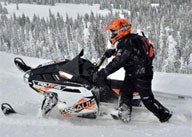
Understanding the BCA Avalanche Air Bag and Avalanche Rescue System
If you have followed Snowmobile.com, then you know we editors are absolute proponents of avalanche safety. This past season, we were equipped with the Back Country Access (BCA) avalanche air bag system (gear pack), beacon, probe and shovel – a complete system. I am proud to say, we did use these – in a passive way – and that’s a good thing. The equipment went with us on every outing. Fortunately we never encountered an emergency where we had to deploy the avalanche air bag system, or engage the beacon, probe and shovel to find a buried snowmobiler. If we had too, then we were properly equipped, and through BCA’s website, educated through its video and printed material.
Why BCA? I like a one-stop-shop. BCA is a company that delivers to any deep-snow backcountry enthusiast the safety tools to save your soul or find a buried victim.
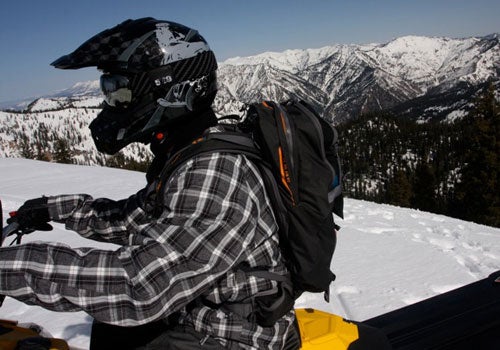 BCA’s Float 30 is well built and provides room for survival kits. The compressed-air delivery system is superbly engineered.
BCA’s Float 30 is well built and provides room for survival kits. The compressed-air delivery system is superbly engineered.For the 2011-2012 season we equipped ourselves with BCA’s Float 30 avalanche air bag system, two shovels, the A-1 and A-2 with integrated 35cm saw; the carbon 260 probe; and Tracker II beacon. Well-built they are. The equipment, such as the backpack air bag system, showed it is a quality constructed product from its stitching to the heavy-duty material used to assemble the unit. Its compressed-air delivery system is a well-engineered system designed to deliver the compressed air to the airbag on demand. This is not some cobbled together tinker toy structure.
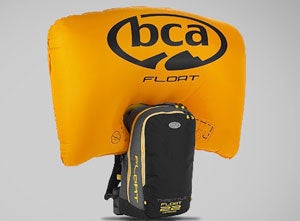 For the 2012-2013 season, BCA has introduced a snowmobile-specific avalanche gear bag that serves the needs of all backcountry riders. (Photo courtesy of BCA)
For the 2012-2013 season, BCA has introduced a snowmobile-specific avalanche gear bag that serves the needs of all backcountry riders. (Photo courtesy of BCA)One night, before my first outing, I sat on the family couch and handled every part of the air bag backpack. I could not find any less-than-quality workmanship. Because mountain riding can be treacherous, you want the best gear you can get and I am very picky about survival equipment. The Float 30 showed durability.
The Float 30 pack provides ample room for many gadgets, tools, and spare gear. It provided sufficient room to protect my equipment, especially from moisture. The zippers and latches are specifically designed to keep water out.
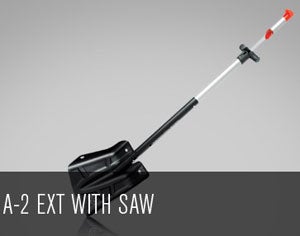 The many shovels from BCA can be purchased with an integrated saw or probe. These shovels are strong to move heavy snow. (Photo courtesy of BCA)
The many shovels from BCA can be purchased with an integrated saw or probe. These shovels are strong to move heavy snow. (Photo courtesy of BCA)However for us, and this not BCA’s fault, we found the large backpack to be bulky for our need. We had chosen this larger sized backpack as a means to carry camera equipment and more, but with all the equipment we stuffed into it, it knocked out our center-of-balance when negotiating tight situations. I was counseled by BCA to wear a smaller backpack, but did not heed.
So, when choosing an avalanche airbag system, such as the Float, choose a size that best fits your riding style, as well as your needs. This season, BCA introduced a new airbag backpack, the Float Throttle. BCA told us the Float Throttle is designed specifically for snowmobilers to include dedicated shovel and probe pockets, and waist belt pockets. Its compressed-air pull trigger is located on the right shoulder strap where the left hand pulls the trigger allowing the right hand to squeeze the throttle. The trigger can be pulled with a gloved hand. The unit’s overall size is optimal for backcountry snowmobilers.
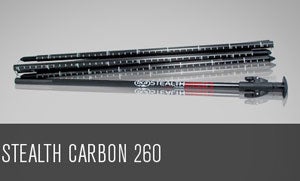 BCA’s probes come in varying lengths and are made to withstand harsh probing through concrete-hard snow. (Photo courtesy of BCA)
BCA’s probes come in varying lengths and are made to withstand harsh probing through concrete-hard snow. (Photo courtesy of BCA)Given that, it is the avalanche airbag system that is crucial. Better large, or small, than not at all.
The many shovel and probes BCA offers are robust and are designed for that needed rescue, if an unfortunate event should occur. I admire BCA’s workmanship. The probe we tested had an extended length of 8-feet 6-inches or 260 centimeters, and was made of carbon fiber, which is both rugged and light in weight. The rescue shovel we evaluated had a sharp saw integrated within the handle. Compact. Nice.
I am a proponent of BCA’s equipment due to, as already stated, the company having all the products and education material to protect the rider and to be an active participant in a rescue. BCA is a fully engaged snowmobiling, backcountry skiing and snowboarding enthusiast’s company. BCA has on its website training videos and printed material to cover such topics as beacon use and the ABCs of probing and shoveling.
Inside The Pack
For several years now, I have taken to the sport of long-distance endurance road cycling, riding in single-day events that are 105 to 205 miles long. Nutrition and hydration are important to me. What I’ve learned from being on the bike saddle from five- to 11-hours is this: sugary or starch-heavy junk foods are not for the body when demanding much from our arms and legs; and if a situation should arise, to survive the night in the cold.
If you should have time before a long backcountry ride, go to a sports nutrition store and purchase some products from Hammer, EFS or Gu, just to name a few. Fill your water bottles with water and a properly balanced electrolyte, potassium, and carbohydrate blend powder. Products such as Hammer’s Heed or Gu’s Rocktane will help prevent muscle cramps, and will provide the energy to stay sharp. Plain water is good to keep with you at all times, and with the hydration blend just mentioned, rounds out the hydration your body needs.
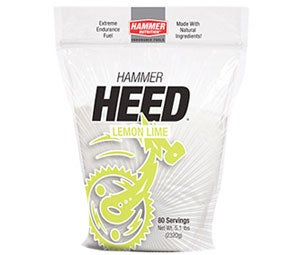 Proper hydration, like nutrition, is paramount to maintaining muscle strength while whacking on the mountains for several hours. (Photo courtesy of Hammer Nutrition)
Proper hydration, like nutrition, is paramount to maintaining muscle strength while whacking on the mountains for several hours. (Photo courtesy of Hammer Nutrition)For food, as a suggestion, place jerky, almonds, and nutrition bars in the gear pack. I like Clif, Tiger’s Milk, Power Bar, Bonk Breaker or Hammer bars that are balanced with protein and carbs, and have a whole grain mix to slowly release energy rather than delivering a carb and sugar spike that leads to a crash. These bars are light and compact, and with several in a gear pack, one can survive several days in the wilderness on nutrition bars as companion survival products to water, jerky and nuts. Avoid high caffeine energy drinks. These are a diuretic, meaning; you’ll often be running behind a tree to water the bushes. In essence, you’ll be dehydrating.
In my gear pack, I have two separate individual soft boxes, one soft box for fire starting and signaling products; the other, medical. Here, I suggest visiting a reputable Army/Navy surplus or emergency/survival store and purchasing waterproof matches, solar blankets, non soap-laced steel wool (for fire starting), signaling mirror, and a high-pitched “howler” whistle.
This brings me to other products. Keep an LED flashlight, screamer/howler whistle, signaling mirror, and a multipurpose tool (Gerber, Kershaw to name two), in your gear pack. The avalanche shovel I use has an integrated saw. All these are essential for spotting/signaling, fixing a snowmobile or building a snow cave.
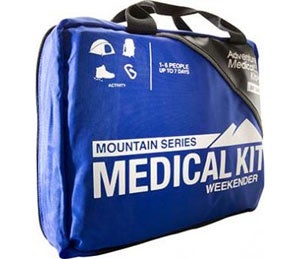 Adventure Medical Kits such as the Origin, Weekender Mountain Series medical kit, and Hybrid 3, provide excellent tools to treat the injured, survive the night and to signal for help. (Photo courtesy of Adventure Medical Kits)
Adventure Medical Kits such as the Origin, Weekender Mountain Series medical kit, and Hybrid 3, provide excellent tools to treat the injured, survive the night and to signal for help. (Photo courtesy of Adventure Medical Kits)Recently I attended a medical/first-aid seminar where I secured three medical, first-aid/survival kits from Adventure Medical Kits to place in my backpack and those of our test riders. These kits provide the survival components to give medical treatment, survive a night in the cold, build a fire and fish for a trout. These kits have the products to treat wounds, burns, scrapes, cuts, sprained ankles, etc. The product website has the products I use and endorse. Here you can order the kits you need, from comprehensive multi-person survival, signaling, first-aid kits, to small and compact single-person kits. What I have is the hand-held SOL (Survive Outdoors Longer), the three-in-one SOL Hybrid (survival, first-aid and gear repair) and the three day Mountain Series medical kit.
In an age of tech, a cell phone with GPS and built in compass is nice, but batteries do die. Keep a compass in your gear pack. Reach back to your Boy Scout days and reflect on compass use and map orientation. Given that, keep a terrain and trail map in your suit or gear pack.
Just because your gear pack is filled with survival and avalanche rescue essentials, without basic knowledge on how to use the gear, especially the search beacon, the victim may lay in more danger due to the rescuer learning how to use the equipment while on the job. Spend time this fall learning how to conduct a search and rescue with your beacon before taking to the snow. If snow is covering the ground, have a friend bury the beacon, unbeknownst to you, and search for it – time and time again. Become proficient.
With that, take an avalanche class, or take some online training; go to http://www.avalanche.org/ and follow the many links. For example, the Bridger-Teton National Forest site has many You Tube and online tutorials. Also, Ski-Doo is offering some avalanche awareness classes that are in-depth and informative. According to Ski-Doo, “Snowmobilers will be able to attend an avalanche awareness seminar free of charge at 24 Ski-Doo dealerships in Canada, 28 in the lower 48 United States and five in Alaska.” Go to Ski-Doo.com to learn more.
In closing, if wanting to purchase avalanche preparedness and rescue equipment, check out BCA’s products. There are others, such as ABS and Sno-Pulse, but BCA supplies me with what I need, plus I like its educational material.
Become familiar with survival foods, signaling and medical equipment that can go inside your backpack, I like Adventure Medical Kits, as these kits are designed for the outdoor recreation (motorized) enthusiast. Keep snowmobiling safe and be backcountry smart.
Related Reading BRP Offers Free Avalanche Awareness Courses Top Deep Powder Products Wild Footage of Snowmobiler Caught in Avalanche [Video]



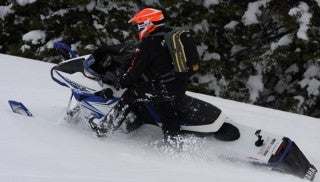
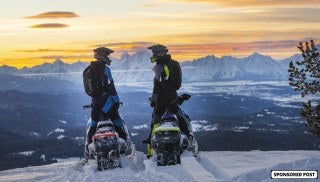



 Your Privacy Choices
Your Privacy Choices